‘Cucina povera’, the Italian description covering the ingenious use of inexpensive or foraged ingredients to make satisfying food (that in the case of caccio e pepe becomes the hip pasta of the moment and therefore absurdly pricey) doesn’t always produce dishes that are in any way beguiling. Tourain, the signature soup of South West France’s département of the Dordogne, is unspeakable. I’m not even going to add In My Humble Opinion.
To make it, copious cloves of chopped garlic are melted in goose fat, flour is stirred in to create a roux then water is poured over to generate a stock the colour of used washing-up water that becomes infused with garlic, the only flavour of this liquid. Next, egg yolks are beaten with a little vinegar into the tourain, to thicken it. Finally the whites are whisked in, in a thin stream, turning them into stringy threads. It is, as Charlie Brown might have said, “Bleugh”.
With Easter’s approach, I am reminded of the only other “Bleugh” dish I’m familiar with: magiritsa. And I am not a food fusspot. I have eaten with varying degrees of relish snake, beetles, ants (lemony), cockroaches (good crunched whole like prawns), guinea pig (I honestly didn’t know it was a Charlie or Harriet or whatever your pet was called until afterwards), and, with less relish, dog. (Until afterwards, I didn’t know it was dog either, the only one on the list that doesn’t taste like chicken. It tastes like rancid beef.)
Magiritsa is a Greek soup eaten immediately following the Saturday midnight service that celebrates the arrival of Easter, to break the Lenten fast. You probably can’t get more sustainable+cucina provera than magiritsa, wasting, as it does, absolutely nothing. It’s made from the offal removed from the stomach of the lamb that will be roasted for the Easter Sunday feast. The addition of chopped Cos lettuce, perhaps some wild dill and other herbs, brings a touch of colour to its grey. In the almost two years I spent living in a fishing village on the north west coast of Epirus, scraping my magiritsa soup plate clean was the prime challenge to keeping whatever measure of respect my neighbours may have held for me intact - much more challenging than being repeatedly but inexplicably arrested and my passport regularly confiscated by the village police chief.
Finishing every last scrape of my magiritsa without gagging was not a total struggle. I had had practice with the even more inedible tripe-and-onions my Australian grandmother created for the pleasure of my Yorkshire grandfather. That, too, was a concoction on the theme of shades of grey (not fifty of them, only one uniformly grim one) in which rings of tripe the texture of rubber bands floated in an onion sauce that hovered between the thickness of gruel and wallpaper paste.
Tripe, the edible lining of the stomachs of ruminants from sheep to giraffes, is so common across the globe that there are dishes made from it that start with every letter of the alphabet except J, Q, R, W, X and Z. Some of it is delicious. Haggis, for instance, even though some contend that the whisky that comes with (to pour over, not to drink) is crucial. Lampredotto, a Florentine speciality in which the fourth and final stomach of the cow is slow-braised in broth with herbs then chopped and rammed into a roll and doused in salsa verde or a spicy sauce, is a great sandwich for strolling around the back streets of the city’s market area.
In menudo, a Mexican tripe soup not to be confused with the Filipino stew of the same name, the lining of a cow’s stomach is slow-cooked with fiery chillies and onions and hominy and herbs and lime to soften the tripe that together distract you from the fact you’re eating tripe - if you need distraction. My grandmother wasn’t overly concerned with softening her tripe. It would have greatly benefitted from the distraction of all the ingredients for menudo and more, but all it got was under-cooked onions, squeaky between the teeth.
You may think the idea of tripe repellent. But enough people are fans for tripe to have its own World National Tripe Day - 24th October, established in 2011 by the Tripe Marketing Board. (Yes, chickadees, pretty much everything has a marketing board.) Our use of the word to convey ‘stupid’ comes from the Middle Ages when only the poor would eat it so the wealthy dismissed anything unworthy of their indulgence as tripe. It’s thought the word may have come from the French, or the Spanish, which in turn may have come from the Arabic ‘therb’, which doesn't in the least sound like ‘tripe’. Those who have poured over the origins of tripe (the Tripe Marketing Board) believe eating it goes back to 600 BC. Well, why not? Hunters aren’t likely to have supported waste.
By Victorian times, tripe received social acceptance across Britain’s comfortable classes, while in France, tripe à la mode de Caen, which originally included the lining from all four stomachs of the cow plus the hooves and bones, is thoroughly respected. Their andouille, on the other hand, (tripe sausage), had the family basset hound backing away from it growling when we consigned our revolting portions to his bowl. Pepper Pot, a thick soupy tripe stew originating in West Africa and the Caribbean, was brought to North America with the slave trade during the nineteenth century by Black women and turned into a dish associated with Philadelphia.
All this to say that although I am an avid supporter of traditions, I don’t any longer think I need to adhere to them if I don’t want to. I shan’t be plunging into magiritsa next Saturday at midnight. Nor shall I be eating roast lamb to celebrate Easter. I am going to eat pork roasted with apples, a celebration, this interminable British winter, of the ending of the long chilly months and their comfort foods before the arrival of the new season’s exhilarating fruits and vegetables. (That’s actually waffle, as you may have guessed. I would eat this at any time of year. Wouldn't you?)
2kg/4lbs 4 oz boneless pork loin
5 cloves garlic, peeled, slivered
salt and freshly ground black pepper, to taste
2 tablespoon duck fat or vegetable oil
several apples (such a Golden Delicious) scrubbed and cored, a knife run lightly round their waists to make a fine cut and prevent them for bursting
Several leaves of fresh sage
2 glasses white wine
Preheat the oven to 180C/350F.
Pierce the pork loin with the point of a knife and insert the slivers of garlic. Rub the joint with salt and pepper and brown it all over in a frying pan in hot duck fat over medium-high heat.
Remove the pork to a roasting pan. Stand the apples upright around the pork, dotting them with a little duck fat. Distribute the sage leaves around the pan and pour the white wine over all. Season with freshly ground black pepper and roast, basting regularly, till the juice become clear, about an hour. Rest for 10 minutes before slicing. Skim the fat off the jus and serve it with the pork and an apple for each person.

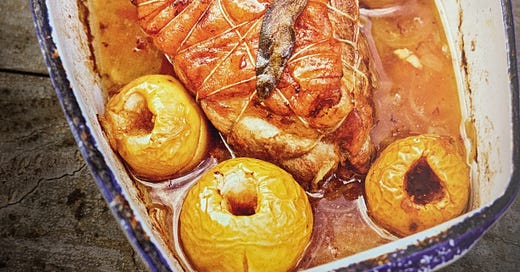


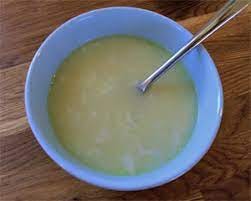
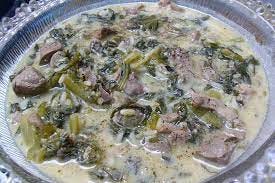
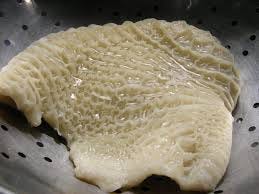
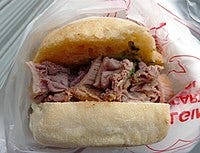
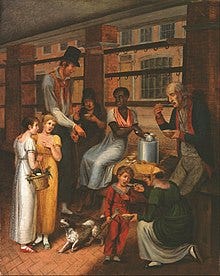

Jeezo, I love your posts. Tripe prepared as you've described sounds repellent. But, pickled, dredged in flour, dipped in egg and fried ... well, that's a delicious meal served with a great big salad. As the daughter of a fisherman, my memories of beef linger in the organs department. And I have to say that my mother's pickled tripe was a favorite to my child self. Give it a try!
You should taste the stuffed lamb tripe prepared the Lebanese way, if you can get someone to make it. The small pouches are washed and rubbed with lemon juice, vinegar and orange blossom water. The stuffing is rice, minced meat, chick peas, onions and toasted pine nuts. After the stuffed and sewn up pouches are cooked until tender with spices and bay leaves, they are scooped out of the pot and placed in a pan to toast in the oven. When golden, the small stomachs are slit open and eaten with cold yogurt and a little of the broth. Nobody makes this dish anymore. I remember my grandmother making it. We used to run out of the house when she did. Much later in life, when I was a guest at my lawyer’s house, I politely sampled some his mother had prepared. It was not all that bad, and toasted after cooking, the texture was a little more tolerable.